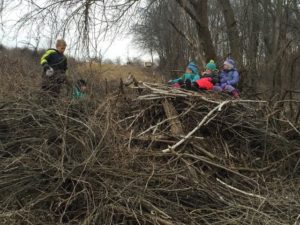Building a Better Brushpile
Many of the books and articles about creating or improving habitat advocate building brushpiles. And in my experience, this advocacy is justified. Little birds shelter in them on winter nights, rabbits live in them year round, predators like hawks and mink visit regularly to check out the menu, frogs hibernate below over winter, etc.
If you are considering building one, remember that the main purpose is shelter, and it will function better if placed in a sheltered location, especially if it can be out of the coldest winter wind, which comes from the northwest. (See my blogs about microhabitats for more about sheltered locations on the landscape.)
A good design is to begin with two layers of logs laid at right angles, or one layer of stumps, either of which creates cavities at the bottom when covered with brush and branches. Lacking that, one or two layers of wooden pallets will serve, but consider the nails they will release when they decay away. Then just keep adding brush, branches, logs, and stumps – preferably yearly.

A Prairie Green class playing a game on their “stickpile” in 2016.

Prairie Green children burrowing into the composted brushpile in 2017.
Our oldest brushpile at home is perhaps 35 years old and continues to evolve. Over the past 7 years much of my brush and branches supply has been diverted elsewhere to help build windrows for growing pipevine for the pipevine swallowtail butterfly, (see: Rare Butterfly Plantation 2017). Consequently, the composted core of the old brushpile has gradually become exposed and the Prairie Green schoolchildren took it over for a playground and learned they could tunnel right into the crumbly compost.
This year, summer storms left a lot of white pine debris for me to clean up, some of which made its way onto the children’s’ stickpile.

White pine branches added in 2018. Looking west, note the sheltered location low on the landscape.
We know that this brushpile is working well. Every day there is a hawk perched above it in the trees. Every winter the snow around it is packed down with bunny tracks. If I climb the lee side in the cold, windy twilight, little birds come streaking out (they are going to love those bundles of long pine needles).
If you want to build a habitat brushpile and make it part of your landscaping, perhaps as another way to watch wildlife from your windows, consider using it as a 3-D trellis and grow native vines over it. Perennial natives might include Virginia creeper (bird berries and brilliant autumn leaves), trumpet vine (hummingbirds, but aggressive so make sure you can deal with them), moonseed (bird berries, but are toxic to people), trumpet honeysuckle (hummingbirds, see my earlier blogs), pipevine (for the pipevine swallowtail butterfly, see my earlier blogs), or wild grapes (bird berries). Garden annuals could include morning glory, scarlet runner bean, climbing nasturtium, gourds, small pumpkins, etc.
But remember that the brushpile fauna may include woodchucks, whose burrows below a brushpile can later serve as a shelter and hibernation location for frogs, toads, snakes, salamanders, and other critters. Unfortunately, the chucks love fresh garden veggies just as much as you, and they will also tunnel under the shallow slab foundations of sheds and garages. So check with your family and neighbors before building a backyard habitat brushpile. If you are interested in building a brush pile, but don’t have a suitable location, contact Property Stewardship Specialist Jason Taylor to see if there is a favorable site for you to build one on a Bur Oak Land Trust property.
Tags: brushpile, Lon Drake, native habitat

